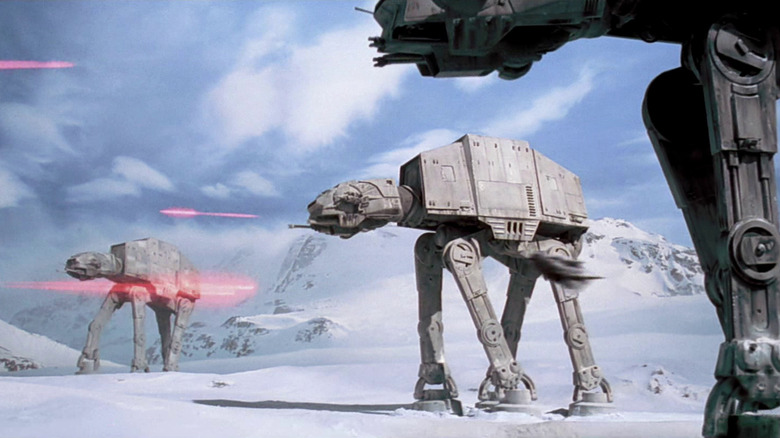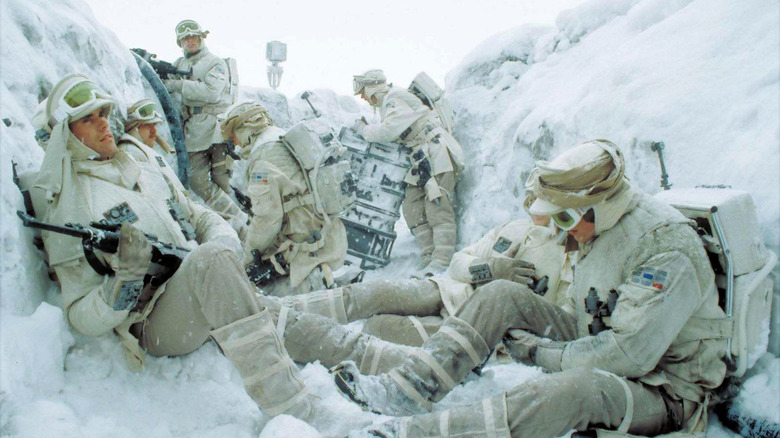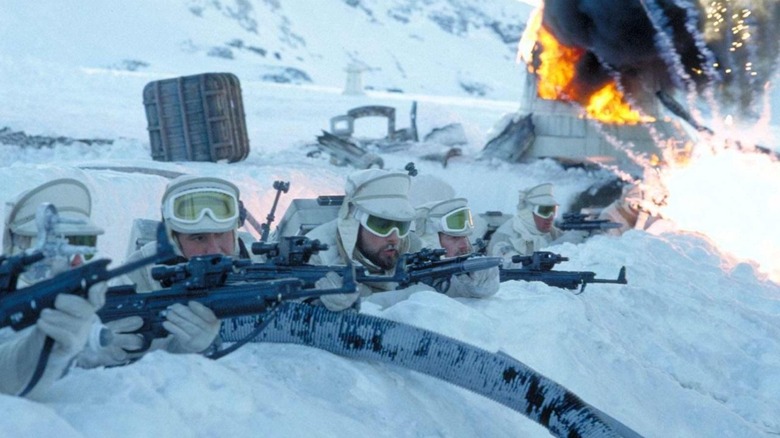The Empire Strikes Back's Battle Of Hoth Had The Help Of The US Army
At the beginning of Irvin Kershner's 1980 film "The Empire Strikes Back," a group of brave rebels has been hiding out from the evil Empire on a distant frozen planet called Hoth. The rebels think they're safe, but an Empire drone locates them. Massive walking tanks are sent to Hoth to destroy the base, and the rebels don't seem able to fight them off. The rest of "Empire" will see the film's protagonists separated and scattered, with some fleeing for their lives and another hiding out on a swamp planet learning how to harness new abilities.
But the Hoth battle is the film's inciting incident, and it's impressive from a special effects standpoint. The walking tanks — called AT-ATs — were stop-motion creations that were inspired by speculative papers on metallurgical futurism, as well as by paintings by an artist named Syd Mead, who envisioned a walking cargo craft built to traverse tough terrain. The AT-ATs were equipped with giant laser canons, and the rebels fought back by firing their own blasters and attacking with two-person, snowspeeders in the air.
The sound effects for the scene were realized by Ben Burtt, the Oscar-winning sound designer behind "Star Wars," the "Indiana Jones" movies, "E.T. the Extra-Terrestrial," and various Pixar movies, as well as the electronic voice of WALL-E in "WALL-E." If you have Indiana Jones' punches, Luke Skywalker's lightsaber, or R2-D2's beeping "language" stuck in your head, you have Burtt to thank.
According to a 2020 interview with StarWars.com, Burtt says that compiled the sounds for the Hoth battle by essentially running around an army base unsupervised, recording various weapons in action. Yes, Burtt probably put himself in real danger.
Army brat
Burtt went on an extended excursion to various military bases where he knew weapons were being tested and carried along his recorder. According to this interview, he was able to capture plenty of explosions and firearms that would eventually be remixed into the weapons fire for his sci-fi picture. He was essentially allowed to build his own sound effects library that was unique to "The Empire Strikes Back." In Burtt's words:
"We spent two weeks going out with the US Army to record all of their weapons. It was like being in basic training, except I didn't have to take orders. The Pentagon Department of Defense arranged for us to travel around and go to different army bases where we did lots of weapons — artillery, small arms, shoulder-launched missiles. And all of that munition — the ricochets, the bullet fly-bys, explosions — became the core material for the snow battle."
Of course, it wasn't just a matter of recording explosives and firearms, but distorting the audio in a way that would make them sound distinctly "Star Wars"-like. In one instance, he slowed down the sound of a bullet bouncing off of a metal plate and morphed it into a fantasy laser blast. Yes, he had to get close. No, it wasn't safe. He knew that. Burtt said:
"You could take a ricochet of a bullet that we recorded and you could slow it down to become a really interesting laser, or an ion cannon or something like that. [...] But looking back at it, you'd be hard-pressed to get that kind of open access today to military activity because of the liability. [...] We had some close calls, where bullets were hitting the ground near us and passing overhead. But we got some good sounds!"
Actual missiles
Burtt also recalled a trip he took to the White Sands Test Center, a missile range in New Mexico. Burtt recalls the amazing show of mechanized violence he witnessed and recorded while there, able to capture the sounds of large, groaning attack vehicles, buzzing flying craft, and the zooming of actual f***ing missiles. More than anything, Burtt recalled the noises themselves, notably the variety of noises. No two weapons sounded quite the same, which was required for the various sci-fi weapons that he wanted to put in "The Empire Strikes Back." Burtt said:
"Those events gave us roaring jet engines and the crackling sounds of launch vehicles ascending. Smaller research rockets would be much faster and whizz by. They would launch drones and shoot them down with interceptor rockets. Those roaring sounds and pyrotechnic elements would work their way into pass-bys of ships and additional sounds for weapons. There's numerous tripod ray guns and turrets in the Battle of Hoth that have turbo lasers on them and they all needed different and distinctive sounds."
Burtt was a little wistful, knowing that the Army, for safety reasons, would no longer allow a filmmaker to step into an active weapons testing facility merely to record the kabooms and pow. That means the sounds in "Empire" will remain unique in perpetuity. No one will be able to record the sounds of Army missiles ever again, especially not how they sounded in 1979. Burtt lamented:
"[T]hese things I recorded at White Sands Missile Range as well as with the Army, they would end up being elements in there for those battle sounds. Recording at White Sands was really a great opportunity. We captured a collection of weapons and rockets that would be very hard to arrange, if not impossible, to do today."


